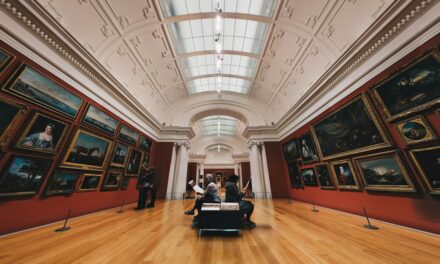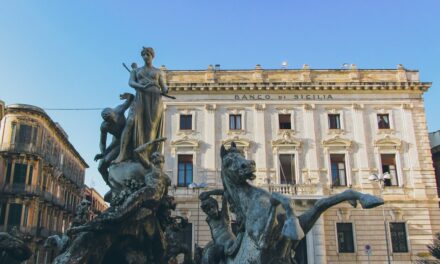Andrew Warhola, later known as Andy Warhol, was born on 6 August 1928 in Pittsburgh, Pennsylvania, to Slovakian immigrant parents. He was the fourth child in the family. Warhol’s early years were characterised by financial hardship and health issues, notably a rare neurological condition called Sydenham’s chorea, which confined him to bed for extended periods.
During his convalescence, Warhol developed a passion for drawing and amassing images of film stars, an interest that would later inform his distinctive pop art aesthetic. Upon recovery, Warhol enrolled at the Carnegie Institute of Technology (now Carnegie Mellon University), where he obtained a degree in pictorial design in 1949. His time at university was marked by experimentation with various artistic media, including drawing, painting and printmaking.
Warhol’s early artistic output was significantly influenced by the commercial art of the 1950s, and he swiftly garnered attention for his innovative approach and unique style. Warhol’s formative years and educational background were instrumental in moulding his artistic vision. His experiences with illness and financial constraints fostered an appreciation for quotidian objects and images, which would later become central themes in his work.
The Carnegie Institute of Technology provided Warhol with opportunities to explore diverse artistic techniques and develop his signature style, which would subsequently transform the art world. These early experiences laid the groundwork for Warhol’s future success as an artist and his seminal contributions to the pop art movement.
Summary
- Andy Warhol was born in Pittsburgh, Pennsylvania in 1928 and studied at the Carnegie Institute of Technology
- Warhol became a leading figure in the Pop Art movement, known for his iconic Campbell’s Soup Cans and Marilyn Monroe portraits
- The Factory, Warhol’s famous studio, became a hub for artists, celebrities, and socialites, while Studio 54 was a popular nightclub he frequented
- Warhol’s influence on popular culture can be seen in his collaborations with musicians, filmmakers, and fashion designers
- Andy Warhol passed away in 1987, leaving behind a legacy of groundbreaking art and a lasting impact on contemporary culture
The Pop Art Movement
The pop art movement emerged in the 1950s and 1960s as a reaction against the traditional notions of fine art. Artists like Andy Warhol, Roy Lichtenstein, and Claes Oldenburg sought to challenge the elitist nature of art by incorporating popular culture and mass-produced imagery into their work. Warhol’s iconic Campbell’s Soup Cans and Marilyn Monroe portraits are quintessential examples of pop art, as they elevate everyday objects and celebrities to the status of high art.
The movement was characterised by its use of bold colours, commercial imagery, and a sense of irony and detachment from traditional artistic values. Pop art aimed to blur the boundaries between high and low culture, challenging the notion of what could be considered art. The pop art movement had a profound impact on the art world, as it challenged traditional notions of beauty and artistic value.
By incorporating mass-produced imagery and everyday objects into their work, pop artists like Andy Warhol sought to democratize art and make it accessible to a wider audience. The movement also reflected the changing cultural landscape of post-war America, as it embraced consumerism and celebrated the icons of popular culture. Pop art continues to influence contemporary artists and remains a significant force in the art world, thanks in large part to the groundbreaking contributions of artists like Andy Warhol.
The Factory and Studio 54

The Factory was Andy Warhol’s legendary studio in New York City, where he produced some of his most iconic works and hosted a diverse array of artists, musicians, actors, and celebrities. The Factory became a hub for creativity and experimentation, as Warhol and his collaborators worked on a wide range of projects, including films, music, and performance art. The studio also served as a gathering place for the avant-garde and countercultural figures of the 1960s and 1970s, making it a hotbed of artistic innovation and social change.
Similarly, Studio 54 was a famous nightclub in New York City that became synonymous with the hedonistic excesses of the disco era. Warhol was a regular at Studio 54 and often brought his entourage of artists and celebrities to the club, further solidifying his status as a cultural icon. The Factory and Studio 54 were both integral to Andy Warhol’s life and career, as they provided him with a platform to showcase his work and connect with other creative minds.
The Factory allowed Warhol to experiment with different mediums and collaborate with a diverse range of artists, while Studio 54 provided him with a space to socialize and network with the cultural elite. Both spaces were emblematic of the vibrant artistic scene in New York City during the 1960s and 1970s, and they continue to hold a special place in the collective memory of that era.
Warhol’s Influence on Popular Culture
Andy Warhol’s influence on popular culture is undeniable, as his work continues to permeate mainstream media and shape contemporary artistic trends. His iconic images of Marilyn Monroe, Campbell’s Soup Cans, and Coca-Cola bottles have become synonymous with pop art and are instantly recognizable around the world. Warhol’s use of mass-produced imagery and celebrity icons challenged traditional notions of beauty and artistic value, paving the way for future generations of artists to explore similar themes.
His impact on popular culture extends beyond the art world, as his work has been referenced in music, fashion, film, and advertising. Warhol’s influence on popular culture can be seen in the way his work has been embraced by mainstream audiences and incorporated into various aspects of contemporary life. His images have been reproduced on everything from t-shirts to coffee mugs, making them accessible to a wide range of consumers.
Additionally, Warhol’s exploration of celebrity culture and consumerism continues to resonate with modern audiences, as it reflects the pervasive influence of mass media on our daily lives. Warhol’s legacy as a cultural icon is firmly established, as his work continues to inspire new generations of artists and captivate audiences around the world.
The Death and Legacy of Andy Warhol
Andy Warhol passed away on February 22, 1987, at the age of 58, following complications from gallbladder surgery. His death sent shockwaves through the art world, as it marked the end of an era and left a void that would be difficult to fill. Warhol’s legacy as an artist and cultural icon was firmly established at the time of his death, but his passing served to further solidify his status as a legendary figure in the annals of art history.
In the years since his death, Warhol’s influence has only continued to grow, as his work remains as relevant today as it was during his lifetime. Warhol’s legacy is multifaceted, encompassing his groundbreaking contributions to pop art, his role as a cultural provocateur, and his enduring impact on popular culture. His work continues to be celebrated in museums and galleries around the world, ensuring that future generations will have the opportunity to experience his unique vision firsthand.
Additionally, Warhol’s influence can be seen in the work of contemporary artists who have been inspired by his innovative approach to art-making. His legacy as an artist and cultural icon is secure, as he continues to be revered for his visionary contributions to the art world.
Warhol’s Most Famous Works

Andy Warhol created a vast body of work during his lifetime, but several pieces have become emblematic of his iconic style and enduring legacy. His Campbell’s Soup Cans series is perhaps his most famous work, as it challenged traditional notions of subject matter in art by elevating a mundane household item to the status of high art. Similarly, his portraits of Marilyn Monroe have become synonymous with pop art and continue to captivate audiences with their bold colours and striking imagery.
Another iconic work is his series of Coca-Cola paintings, which explore themes of consumerism and mass production while showcasing Warhol’s distinctive style. In addition to these famous works, Warhol also created numerous other pieces that have left an indelible mark on the art world. His collaborations with other artists and musicians resulted in groundbreaking projects such as The Velvet Underground & Nico album cover and the Exploding Plastic Inevitable multimedia events.
Furthermore, his films such as “Chelsea Girls” and “Empire” pushed the boundaries of cinematic expression and challenged traditional notions of narrative storytelling. Warhol’s most famous works continue to be celebrated for their innovative approach to subject matter and their lasting impact on contemporary art.
Warhol’s Personal Life
Andy Warhol’s personal life was marked by contradictions and complexities that mirrored his enigmatic public persona. Despite being known for his flamboyant public image and socialite lifestyle, Warhol was notoriously private about his personal life. He was openly gay at a time when homosexuality was still stigmatized in American society but rarely discussed his romantic relationships or personal struggles.
Additionally, Warhol’s near-fatal shooting by Valerie Solanas in 1968 left him with physical scars that he would carry for the rest of his life. Warhol’s personal life also reflected his deep-seated insecurities about fame and success, as he often felt overshadowed by his own public image. Despite being one of the most influential artists of the 20th century, Warhol struggled with feelings of inadequacy and self-doubt throughout his life.
His personal struggles were often reflected in his work, as he used art as a means of processing his emotions and grappling with his own sense of identity. Ultimately, Warhol’s personal life remains shrouded in mystery, adding another layer of intrigue to his already enigmatic legacy. In conclusion, Andy Warhol’s life and career were marked by innovation, controversy, and enduring influence.
His early experiences shaped his artistic vision and laid the foundation for his groundbreaking contributions to the pop art movement. The Factory and Studio 54 were integral to his creative process and social life, providing him with a platform to showcase his work and connect with other creative minds. His influence on popular culture continues to be felt today, as his work remains as relevant as ever.
Despite his untimely death, Warhol’s legacy endures through his most famous works and enigmatic personal life.
If you are interested in learning more about the art movements that influenced Andy Warhol’s work, you may want to read the article on Post-Impressionism on Thinkofart.com. Post-Impressionism was a movement that emerged in the late 19th century and sought to move beyond the naturalism of Impressionism, exploring the use of colour and form to express emotion and meaning. Understanding the context of Post-Impressionism can provide valuable insight into the development of Warhol’s unique style and approach to art. https://thinkofart.com/post-impressionism/
FAQs
Who is Andy Warhol?
Andy Warhol was an American artist, director, and producer who was a leading figure in the visual art movement known as pop art. He was born on August 6, 1928, in Pittsburgh, Pennsylvania, and died on February 22, 1987, in New York City.
What is Andy Warhol known for?
Andy Warhol is best known for his iconic paintings of Campbell’s soup cans, Coca-Cola bottles, and celebrities such as Marilyn Monroe and Elvis Presley. He also created films, sculptures, and other works that explored the relationship between artistic expression, celebrity culture, and advertising.
What is pop art?
Pop art is an art movement that emerged in the 1950s and 1960s in the United States and the United Kingdom. It presented a challenge to traditional fine art by incorporating imagery from popular and mass culture, such as advertising, comic books, and everyday objects.
What are some of Andy Warhol’s most famous works?
Some of Andy Warhol’s most famous works include “Campbell’s Soup Cans” (1962), “Marilyn Diptych” (1962), “Gold Marilyn Monroe” (1962), “Elvis I and II” (1963), and “Coca-Cola (3)” (1962).
What was Andy Warhol’s artistic process?
Andy Warhol’s artistic process often involved the use of silkscreen printing, which allowed him to reproduce images multiple times with slight variations. He also used a variety of media, including painting, drawing, photography, and film.
What is the legacy of Andy Warhol?
Andy Warhol’s legacy is that of a pioneering figure in the pop art movement and a cultural icon whose work continues to influence contemporary art, fashion, and popular culture. His exploration of consumerism, celebrity, and mass media has had a lasting impact on the art world.




